NSG 210
West Kentucky Community And Technical College
Page 4 out of 39 results
Sort by
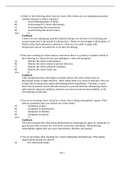
-
Chapter 18, Caring for Clients With Cancer
- Exam (elaborations) • 15 pages • 2022
-
- $8.49
- + learn more
1.Which of the following advice does the nurse offer clients who are undergoing unsealed radiation therapy to reduce exposure? A) Avoid drinking plenty of fluids. B) Avoid eating for 3 hours after therapy. C) Avoid applying skin moisturizers. D) Avoid kissing and sexual contact. Ans: D Feedback: Clients who are undergoing unsealed radiation therapy are advised to avoid kissing and sexual contact due to the spread of radioactivity. Clients are encouraged to drink plenty of fluids to hel...
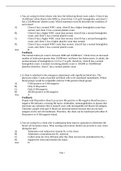
-
Chapter 30, Introduction to the Hematopoietic and Lymphatic Systems
- Exam (elaborations) • 12 pages • 2022
-
- $9.49
- + learn more
1.You are caring for three clients who have the following blood count values: Client A has 24,500/mm3 white blood cells (WBCs), client B has 13.4 g/dL hemoglobin, and client C has a 250,000/mm3 platelet count. Which statement correctly describes the condition of each client? A) Client A has a normal WBC count, client B has a higher hemoglobin count than normal, and client C has a normal platelet count. B) Client A has a higher WBC count than normal, client B has a normal hemoglobin co...
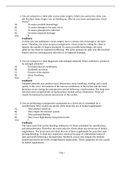
-
Chapter 20, Caring for Clients With Upper Respiratory Disorders
- Exam (elaborations) • 13 pages • 2022
-
- $9.49
- + learn more
1.You are caring for a client who is post–sinus surgery. When you assess this client, you ask him how many fingers you are holding up. Why do you assess postoperative visual acuity? A) To assess possible hemorrhage B) To assess damage to the optic nerve C) To assess postoperative infection D) To assess impaired drainage Ans: B Feedback: A client who has undergone a sinus surgery faces a serious risk of damage to the optic nerve. Therefore, the nurse assesses postoperative visual acui...
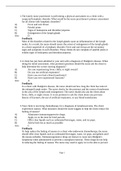
-
Chapter 32, Caring for Clients With Disorders of the Lymphatic System
- Exam (elaborations) • 13 pages • 2022
-
- $9.49
- + learn more
1.The family nurse practitioner is performing a physical assessment on a client with a suspected lymphatic disorder. What would be the nurse practitioner's primary assessment for all clients with lymphatic disorders? A) Fever and sore throat B) Painful joints C) Signs of leukopenia and thrombocytopenia D) Enlargement of the lymph glands Ans: D Feedback: Most of the disorders related to the lymph glands cause an inflammation of the lymph nodes. As a result, the nurse should assess the ...
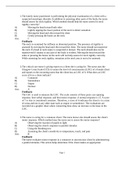
-
Chapter 36, Introduction to the Nervous System
- Exam (elaborations) • 12 pages • 2022
-
- $9.49
- + learn more
1.The family nurse practitioner is performing the physical examination of a client with a suspected neurologic disorder. In addition to assessing other parts of the body, the nurse should assess for neck rigidity. Which method should help the nurse assess for neck rigidity correctly? A) Moving the head toward both sides B) Lightly tapping the lower portion of the neck to detect sensation C) Moving the head and chin toward the chest D) Gently pressing the bones on the neck Ans: C Feedbac...
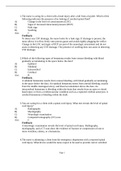
-
Chapter 39, Caring for Clients With Head and Spinal Cord Trauma
- Exam (elaborations) • 13 pages • 2022
-
- $8.49
- + learn more
1.The nurse is caring for a client with a head injury after a fall from a hayloft. Which of the following indicates the presence of/or leaking of cerebral spinal fluid? A) Change in the level of consciousness (LOC) B) Signs of increased intracranial pressure (IICP) C) Halo sign D) Swelling Ans: C Feedback: To detect any CSF drainage, the nurse looks for a halo sign. If drainage is present, the nurse allows it to flow freely onto porous gauze and avoids tightly plugging the orifice. Cha...
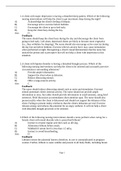
-
Chapter 69, Caring for Clients With Mood Disorders.
- Exam (elaborations) • 12 pages • 2022
-
- $9.49
- + learn more
1.A client with major depression is having a disturbed sleep pattern. Which of the following nursing interventions will help the client to get maximum sleep during the night? A) Acknowledge the client's feeling of despair. B) Encourage active exercise before bedtime. C) Encourage the client to go to bed early. D) Keep the client busy during the day. Ans: D Feedback: The nurse should keep the client busy during the day and discourage the client from going to bed early. Left alone, depre...
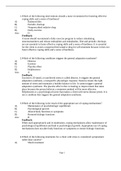
-
Chapter 67, Interaction of Body and Mind
- Exam (elaborations) • 10 pages • 2022
-
- $9.49
- + learn more
1.Which of the following interventions should a nurse recommend for fostering effective coping skills and a sense of hardiness? A) Balanced diet B) Periodic checkup C) Nonprescribed sedative drug D) Daily exercise Ans: D Feedback: A nurse should recommend a daily exercise program to reduce stimulating neurotransmitters and release endorphins and enkephalins. Diet and periodic checkups are not essential to foster effective coping skills and a sense of hardiness. It is essential for the...
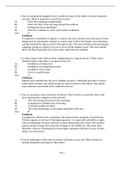
-
Chapter 43, Caring for Clients With Ear Disorders
- Exam (elaborations) • 12 pages • 2022
-
- $9.49
- + learn more
1.You are teaching the daughter how to instill ear drops of her father to remove impacted cerumen. What is important to teach this woman? A) Insert the irrigating syringe deeply. B) Direct the flow of the ear drops toward the eardrum. C) Refrigerate before instillation. D) Place the container in warm water before instillation. Ans: D Feedback: If irrigation or instillation of liquids is ordered, the nurse should warm the liquid to body temperature by placing the container in warm water....

Did you know that on average a seller on Stuvia earns $82 per month selling study resources? Hmm, hint, hint. Discover all about earning on Stuvia


